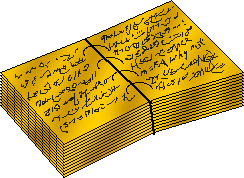Enos

Nombre de messages : 578
Age : 52
Date d'inscription : 16/10/2008
Chevalier de Kolob - Vers la Sagesse
 A reçu la Lumière: 100 A reçu la Lumière: 100
 En quête du Vase Précieux et Elu: En quête du Vase Précieux et Elu:
    (10/200) (10/200)
 A la recherche du couple de Licornes du Jardin d'Eden: A la recherche du couple de Licornes du Jardin d'Eden:
    (2/700) (2/700)
 |  Sujet: Catacombs of Paris Sujet: Catacombs of Paris  Mar 21 Oct - 15:12 Mar 21 Oct - 15:12 | |
| 
Crypt of the Sepulchral Lamp in the Catacombs of Paris
The Catacombs of Paris or Catacombes de Paris are a famous underground ossuary in Paris, France. Organized in a renovated section of the city's vast network of subterranean tunnels and caverns towards the end of the 18th century, it became a tourist attraction on a small scale from the early 19th century and has been open to the public on a regular basis from 1867. The official name for the catacombs is l'Ossuaire Municipal.
This cemetery covers a portion of Paris's former mines near the Left Bank's Place Denfert-Rochereau, in a location that was just outside the city gates before Paris expanded in 1860. Although this cemetery covers only a small section of underground tunnels comprising "les carrières de Paris" ("the quarries of Paris"), Parisians today popularly refer to the entire network as "the catacombs".

History
Paris CatacombsMost of Paris's larger churches once had their own cemeteries, but city growth and generations of dead began to overwhelm them. From the late seventeenth century, Paris's largest Les Innocents cemetery (near the Les Halles district in the middle of the city) was saturated to a point where its neighbors were suffering from disease, due to contamination caused by improper burials, open mass graves, and earth charged with decomposing organic matter.
After almost a century of ineffective decrees condemning the cemetery, it was finally decided to create three new large-scale suburban cemeteries and to condemn all existing within the city limits; the remains of all condemned cemeteries would be moved discreetly to a renovated section of Paris's abandoned quarries. The use of the depleted quarries for the storage of bones, based on the idea of Police Lieutenant General Alexandre Lenoir, was established in 1786 by his successor, M. Thiroux de Crosne, under the direction of Charles Axel Guillaumot, Inspector General of Quarries.
Remains from the cemetery of Saint-Nicolas-des-Champs were among the first to be moved. Bodies of the dead from the riots in the Place de Grève, the Hotel de Brienne, and Rue Meslee were put in the catacombs on August 28 and August 29, 1788.

Bone pile in Parisian Catacombs
The catacomb walls are covered in graffiti dating from the eighteenth century onwards. Victor Hugo used his knowledge about the tunnel system in Les Misérables. In 1871, communards killed a group of monarchists in one chamber. During World War II, Parisian members of the French Resistance used the tunnel system. Also during this period, German soldiers established an underground bunker in the catacombs below Lycée Montaigne, a high school in the 6th arrondissement.
The underground tunnels and chambers have long posed safety problems for construction in Paris. Quarries sometimes cave in, occasionally resulting in a hole in the ground above and causing damage to buildings. To prevent this, the IGC, Inspection générale des Carrières (General Inspection of the Quarries), was established in 1777 by the government in order to monitor the current quarries and prohibit the digging of new quarries. The IGC did, however, dig observation tunnels in order to provide themselves with better access to the quarries so that they might better monitor, repair, and map the consolidated quarries.
The monitoring and consolidation work has continued to this day. Because of the number of quarries, subway, train, and sewer tunnels that have been dug underneath Paris, as well as the softness of the stone involved, extra caution is taken when new construction is attempted or new tunnels are dug. However, this did not prevent problems during the digging of Paris Métro Line 14.
Web http://en.wikipedia.org/wiki/Catacombs_of_Paris | |
|

